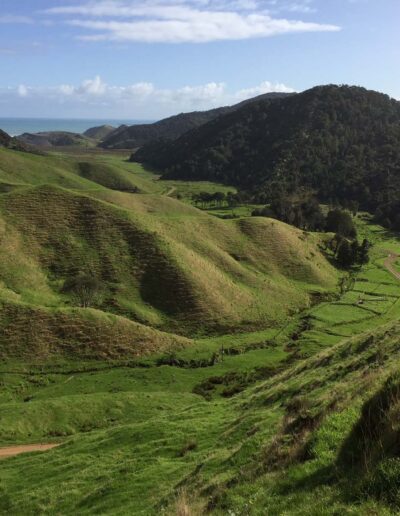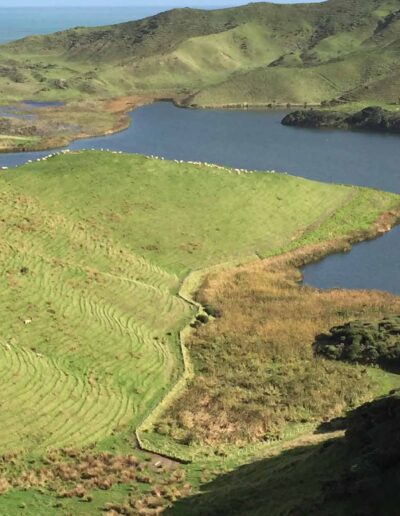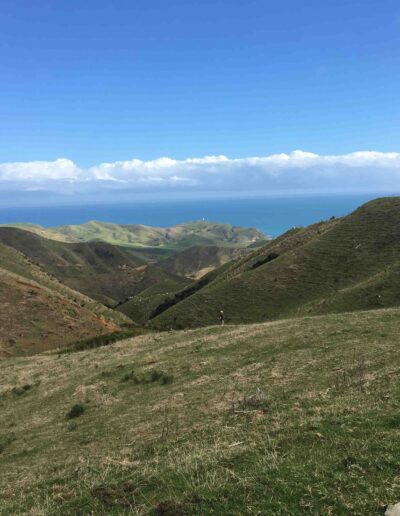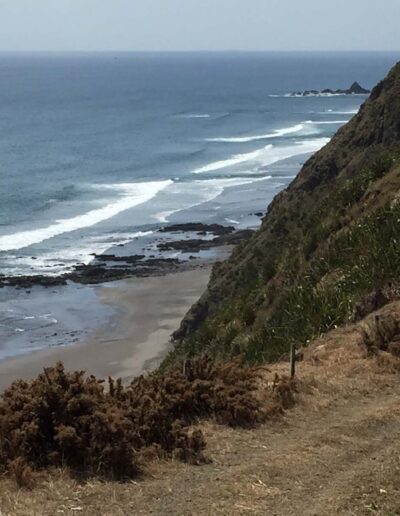Taumatamoana Station Ltd.
Now renamed as Taumatamoana Station, this expansive coastal sheep and cattle ranch encompasses 3285 hectares within the Te Anga district, situated approximately 60km west of Otorohanga. The property encompasses approximately 920 hectares of gently undulating hill country, 1000 hectares of steeper pastures, 1000 hectares of native bush, and 370 hectares of nearly mature Radiata pine forest.
Functioning as a sheep and beef enterprise, the station comprises around 20,000 stock units, comprised of Perindale ewes. Over the past three years, high-performance Romney rams have been strategically utilized to enhance overall sheep performance. The property is also home to a select Angus herd boasting 900 cows, carefully cultivated to achieve further genetic advancements. Meticulous selection of high-performance bulls over the years has cultivated an enticing “Angus-pure” lineage.
Upon acquisition in August 2015, substantial investment was channelled into fencing renovations, as a considerable portion of the property was partitioned with electric fencing, which posed farming challenges. Encompassing approximately 1000 hectares of native bush, the property offers a lifestyle hunting incentive, teeming with an abundance of pigs, deer, and goats. The last three years have witnessed significant investment in sub-divisional fencing, complemented by a comprehensive lane system, markedly enhancing stock management efficiency. With enhanced pastures and additional sub-divisional fencing, the property has the potential to support 25,000-27,000 stock units.
Given the limited flat terrain, approximately 100 hectares of such land have been converted to forage crops. The long-term objective is to reintroduce these areas to permanent, high-performing pastures. Forest cover encompasses around 370 hectares, with 200 hectares nearing the harvest stage. The revenue generated from forest harvesting has significantly contributed to infrastructure enhancement and a substantial fencing initiative. Graced with stunning coastal vistas, the farm’s unique coastal location holds tourism potential. The property’s highest point, Hari Hari trig, reaches an elevation of 418 meters.
This property is run with a management team including the owners, farm manager and outside advisors. The Station has five permanent staff with commercial contractors to cover such requirements as fencing, shearing and weed control.
The team is as follows:
- Farm Manager (Brent and Dianne Gowler)
- Two full-time senior shepherds
- General maintenance and caretaker
- Junior shepherd
Taumatamoana Station operates under a comprehensive “FARM-PRIDE PROGRAMME,” anchoring their farming approach. Fondly referred to as “TMS,” the station’s picturesque allure is heightened by its coastal setting, offering panoramic views of the Tasman Sea.
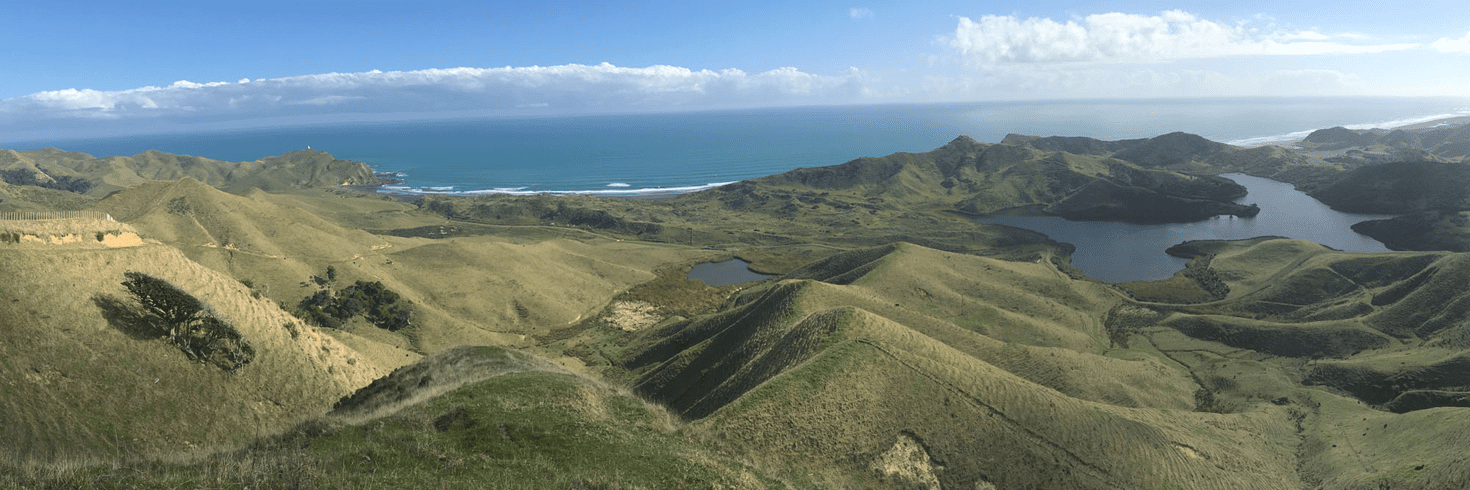
Historical Journey
In 1907, Hari Hari Station emerged as a fledgling sheep farm under the stewardship of Mr. George Riddell from Taranaki. His son, Jack Riddell, assumed the reins around 1915, situating the property in proximity to Lake Hari Hari, a namesake that endured.
Preceding the Riddell era, the farm hosted a flax mill operated by Bell Bros and Ross. This duo had previously managed a Flax operation in Maracopa until its unfortunate 1903 demise. Subsequently, they shifted operations to Hari Hari Station, where flax from the Tauhua swamp was ferried to the mill via tramline. Wool and flax fiber bales embarked on a journey from drays to the shoreline and surf boats, then onto awaiting steamers. This industrious endeavor persisted until January 1929, yet the mill continued its operation at Hari Hari until 1908, when the “KAWHIA SETTLER” reported its closure due to unfavorable fiber prices.
During this epoch, livestock embarked on a coastal journey to Marokopa, eventually arriving at the Waitara freezing works. Stock also found new homes at the Westfield works in Onehunga near Auckland. Fond recollections by Mr. George Goddard, a future Te Kuiti resident, paint a vivid picture of his boyhood contributions to Hari Hari Station, with cattle yards supported by native Puriri strainers and Kauri rails.
January 1929 marked a tragic chapter when Jack Riddell’s untimely demise left no will. The NZ Public Trust assumed control until 1951, overseeing various managerial transitions until the property was returned to Huia (Jack’s daughter) and her mother, Mrs. Riddell. 1951 witnessed Huia and Horrie Forbes reclaiming ownership, further expanding the property by an additional 800 acres. Through the years, Horrie and Huia’s tireless efforts continued, followed by a lineage of caretakers, including their children John, Shane, and Maea (Muff), along with her husband Allen Marshall. Subsequent stewardship passed to Tony Harwood and his wife Jackie. Mr. Horrie Forbes’ passing in 1987 left a legacy, survived by his wife, Huia, and their three children. In 1988, Mrs. Riddell departed, and Huia now resides in Hamilton. The property transitioned to the Maori Taharoa C block in 1995 as an investment.
In December 2003, Mr. John Gallagher acquired approximately 1100 hectares on Taumatatotara West Road, aptly naming it Taumatamoana Station, translating to “Top of the hill to the Ocean.” Expansions followed in 2006, adding two adjacent properties and culminating in a 1600-hectare expanse. Further growth occurred in 2013 with the acquisition of the neighboring Hari Hari block, elevating the station’s footprint to 3285 hectares, solidifying its place among the larger coastal Stations in the King Country.
August 2015 marked a pivotal moment, as John McOviney of Palmerston North secured the property from the Gallaghers, entrusted to his family’s Steelfort Family Trust. John McOviney’s more than 40-year commitment to farming, including the sale of his Rangitikei district property, Potaka Station Ltd, culminated in his focused attention on developing Taumatamoana Station Ltd. His vision revolves around cultivating a high-performing sheep and cattle station, manifested through the stock’s quality and productivity.
Notably, Taumatamoana Station’s history intertwines with early Maori presence, as the legacy of Tainui canoes and their enduring presence along the southern Kawhia harbor shores echoes through the property’s significance. The echoes of history reveal that even the current Maori king, Kiingi Tuheitia, sought solace on Hari Hari Station during bygone holidays. The Kawhia district, deeply enmeshed in cultural and spiritual importance for the Tainui Iwi, stands as a poignant reminder. The station’s proximity to the Taharoa Iron and Sand Mining company is underscored by the presence of two beacons, serving as prominent markers for the iron-sand shipping route.

